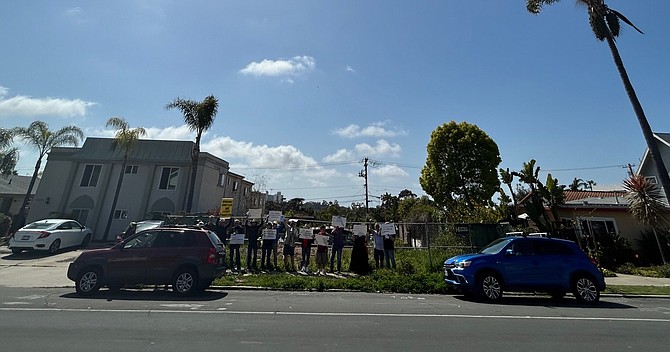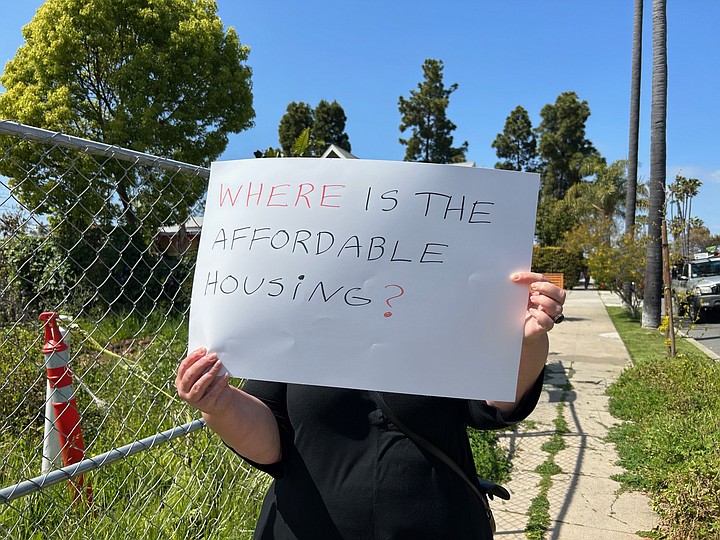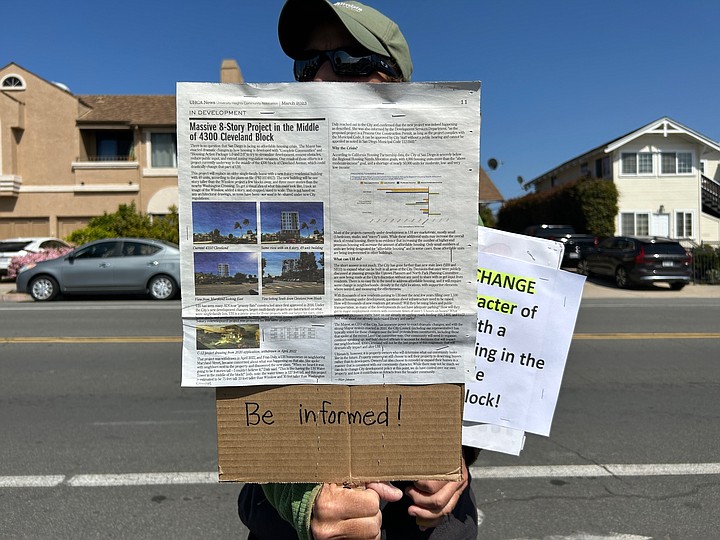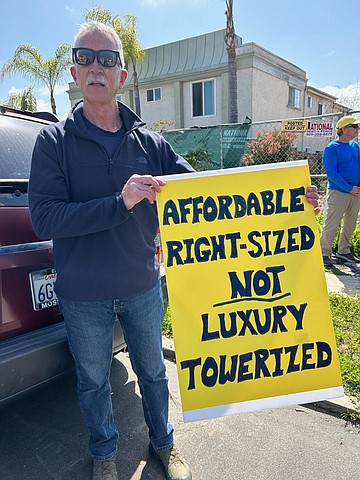 Facebook
Facebook
 X
X
 Instagram
Instagram
 TikTok
TikTok
 Youtube
Youtube

Several dozen community members gathered in front of 4350 Cleveland Avenue (at Meade) in University Heights on Saturday April 15, to protest the pending 49-unit, eight-story “affordable housing” building slated for construction on the quiet residential street.
The lot is nestled between a two-story apartment building and a classic Craftsman home in this historic neighborhood.

“I’ve been here 25 years,” neighbor Phil told me. “It’s just a shock that any structure so large would be put into a residential section of a neighborhood.”
However, the problem presents larger than just the building itself, it’s about how the city is churning out these not really "affordable living" buildings in random areas, with little oversight, zero community input, and in this case, zero benefit to the community.
Marc Johnson and Kristin Harms co-chairs of the grassroots organization, We Are University Heights organized the protest and spoke to me about what’s going on.

“The community stumbled upon the permits for the 8-story building – with limited parking – and we all said what the heck, this is not the location for that,” Johnson explained. “They haven’t told us exactly how many affordable units there will be out of the 49 here but from what I understand it will be two.”
Additionally, San Diego has a strong Mayor system of government many believe exacerbates the issue:
“With ministerial approval it means within the development services department they can just sign off, there is no debate, no public disclosure, and they are rubber stamping everything,” Johnson said. “They’re planning to put about 40 to 50 more of these around University Heights and North Park.”
Johnson estimates more than 5,000 new residents will be coming into the area within the next few years and adding up all the projects on the horizon, the infrastructure is not there.
“We agree the housing crisis is 100 percent real in San Diego, but this is not going to solve that problem…our group is proposing several solutions-we are not opposed to affordable housing…we are not NIMBYS, we are saying yes in my backyard, in the right location, we want smart, targeted density,” Johnson added.

Bill Ellig who was a member of Uptown Planners for five years agrees:
“We were very much involved in the 2016 Uptown plan,” Ellig said. “Right now, in other parts of the city, like the Talmage area, SDSU, UTC area – they are going through a community planning process and there’s a lot of discussion there. That is where the discussion should take place, that’s where the planning should go in – not with these municipal code changes, Complete Communities, Complete Communities 2 and the rest of them which override our community plan. Things need to be planned, there’s a right place for it and a wrong place for it.
"We’re not saying oh no not here, there are probably a hundred units or more on this block because there are a lot of them behind that people don’t see, there’s a lot of natural infill, so, we need proper placement, proper transitions between the higher density and the lower density. At Meade & Park boulevard we have eight stories, right across the street a single-story family house, that is bad planning. The Complete Community Plan even says they have to have proper transitions…this is not rocket science, I’m sorry, but here we have outside investors who don’t live here that are buying up the properties.”
“I haven’t seen the report,” Johnson said. “And now there is talk about other programs being launched by the mayor and the Development Services Department, all of this stuff is moving ahead with no oversight because we have a mayor who is C.E.O. of the city....
We’re talking about possibly having a strong mayor referendum in 2024, there are people starting that groundwork. And we are recommending that the city stop the Complete Communities program, just stop it right here because it’s going to ruin our communities.”
“We want to see our community planners be empowered again to see the projects so that we can all go there and see what the developers propose, that’s how it used to work, we don’t get that anymore,” Harms stated.
In 2011, the planning department and development services were combined. “They do not belong together,” she continues. “Planning is about planning, about the community plan, about community input. Development services is about building – it’s about allowing stuff like this to go in, they do not belong together, they need to be split up.”

“None of this conversation is about whether we should be building, it's strictly about where should that housing go – and that’s the point we’re trying to get out.” Attendee resident Jeff explained: “It’s a fantastic opportunity to sort of reshape how we do planning and create community…the strong mayor system, we voted for it, we said okay let’s make the strong mayor system but it has turned out to be the autocratic system, we never thought the strong mayor system meant a weak council system. “
One woman who marched alongside Todd Gloria, feels he betrayed his climate action plan. “This is not protecting our environment. I marched with Todd Gloria some years ago for the Climate Action Plan and I thought he was a good guy, he was gonna help with climate and diversity. This is not going to provide diversity in our neighborhoods, these are luxury townhomes, they are not going to be affordable. I heard one politician say these townhomes are going to provide housing for the homeless, can you tell me what homeless person is going to be able to afford, at the least, $3,000 a month for housing? So, when it comes to climate change – this adds more density, more traffic…and this lovely Craftsman two-story home, what about their back yard, what if they’re growing their vegetables? What if they have solar panels? There is so much wrong with this, it betrays the Climate Action Plan that I believed in. Todd Gloria has betrayed us.”
“There isn’t any other tool in the box our politicians pull out except getting rid of regulations and allowing whatever’s happening,” Bill told me. “It’s absolutely crickets when you ask them what about rent control or a vacancy tax for units that are kept off the market. Crickets. And the problem is just getting worse…everything they are doing is making everything worse and their only answer is to keep doing more and maybe it’ll eventually change? That’s the definition of insanity.”
A man standing next to me, John Hartley, summed it up perfectly.
“I would just say the city doesn’t care. They don’t care to care, and they don’t listen.”


Several dozen community members gathered in front of 4350 Cleveland Avenue (at Meade) in University Heights on Saturday April 15, to protest the pending 49-unit, eight-story “affordable housing” building slated for construction on the quiet residential street.
The lot is nestled between a two-story apartment building and a classic Craftsman home in this historic neighborhood.

“I’ve been here 25 years,” neighbor Phil told me. “It’s just a shock that any structure so large would be put into a residential section of a neighborhood.”
However, the problem presents larger than just the building itself, it’s about how the city is churning out these not really "affordable living" buildings in random areas, with little oversight, zero community input, and in this case, zero benefit to the community.
Marc Johnson and Kristin Harms co-chairs of the grassroots organization, We Are University Heights organized the protest and spoke to me about what’s going on.

“The community stumbled upon the permits for the 8-story building – with limited parking – and we all said what the heck, this is not the location for that,” Johnson explained. “They haven’t told us exactly how many affordable units there will be out of the 49 here but from what I understand it will be two.”
Additionally, San Diego has a strong Mayor system of government many believe exacerbates the issue:
“With ministerial approval it means within the development services department they can just sign off, there is no debate, no public disclosure, and they are rubber stamping everything,” Johnson said. “They’re planning to put about 40 to 50 more of these around University Heights and North Park.”
Johnson estimates more than 5,000 new residents will be coming into the area within the next few years and adding up all the projects on the horizon, the infrastructure is not there.
“We agree the housing crisis is 100 percent real in San Diego, but this is not going to solve that problem…our group is proposing several solutions-we are not opposed to affordable housing…we are not NIMBYS, we are saying yes in my backyard, in the right location, we want smart, targeted density,” Johnson added.

Bill Ellig who was a member of Uptown Planners for five years agrees:
“We were very much involved in the 2016 Uptown plan,” Ellig said. “Right now, in other parts of the city, like the Talmage area, SDSU, UTC area – they are going through a community planning process and there’s a lot of discussion there. That is where the discussion should take place, that’s where the planning should go in – not with these municipal code changes, Complete Communities, Complete Communities 2 and the rest of them which override our community plan. Things need to be planned, there’s a right place for it and a wrong place for it.
"We’re not saying oh no not here, there are probably a hundred units or more on this block because there are a lot of them behind that people don’t see, there’s a lot of natural infill, so, we need proper placement, proper transitions between the higher density and the lower density. At Meade & Park boulevard we have eight stories, right across the street a single-story family house, that is bad planning. The Complete Community Plan even says they have to have proper transitions…this is not rocket science, I’m sorry, but here we have outside investors who don’t live here that are buying up the properties.”
“I haven’t seen the report,” Johnson said. “And now there is talk about other programs being launched by the mayor and the Development Services Department, all of this stuff is moving ahead with no oversight because we have a mayor who is C.E.O. of the city....
We’re talking about possibly having a strong mayor referendum in 2024, there are people starting that groundwork. And we are recommending that the city stop the Complete Communities program, just stop it right here because it’s going to ruin our communities.”
“We want to see our community planners be empowered again to see the projects so that we can all go there and see what the developers propose, that’s how it used to work, we don’t get that anymore,” Harms stated.
In 2011, the planning department and development services were combined. “They do not belong together,” she continues. “Planning is about planning, about the community plan, about community input. Development services is about building – it’s about allowing stuff like this to go in, they do not belong together, they need to be split up.”

“None of this conversation is about whether we should be building, it's strictly about where should that housing go – and that’s the point we’re trying to get out.” Attendee resident Jeff explained: “It’s a fantastic opportunity to sort of reshape how we do planning and create community…the strong mayor system, we voted for it, we said okay let’s make the strong mayor system but it has turned out to be the autocratic system, we never thought the strong mayor system meant a weak council system. “
One woman who marched alongside Todd Gloria, feels he betrayed his climate action plan. “This is not protecting our environment. I marched with Todd Gloria some years ago for the Climate Action Plan and I thought he was a good guy, he was gonna help with climate and diversity. This is not going to provide diversity in our neighborhoods, these are luxury townhomes, they are not going to be affordable. I heard one politician say these townhomes are going to provide housing for the homeless, can you tell me what homeless person is going to be able to afford, at the least, $3,000 a month for housing? So, when it comes to climate change – this adds more density, more traffic…and this lovely Craftsman two-story home, what about their back yard, what if they’re growing their vegetables? What if they have solar panels? There is so much wrong with this, it betrays the Climate Action Plan that I believed in. Todd Gloria has betrayed us.”
“There isn’t any other tool in the box our politicians pull out except getting rid of regulations and allowing whatever’s happening,” Bill told me. “It’s absolutely crickets when you ask them what about rent control or a vacancy tax for units that are kept off the market. Crickets. And the problem is just getting worse…everything they are doing is making everything worse and their only answer is to keep doing more and maybe it’ll eventually change? That’s the definition of insanity.”
A man standing next to me, John Hartley, summed it up perfectly.
“I would just say the city doesn’t care. They don’t care to care, and they don’t listen.”
Comments